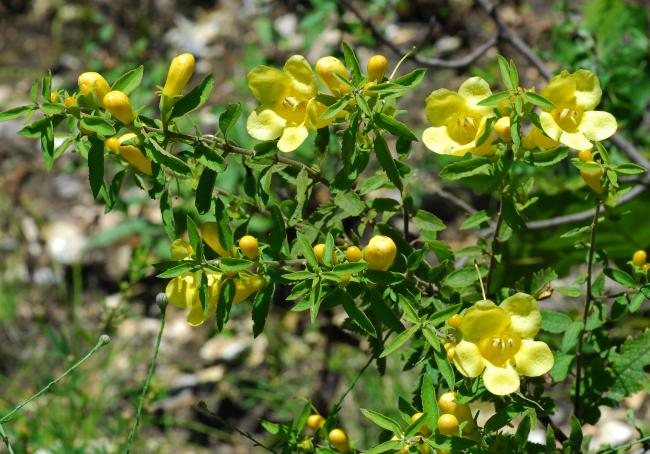Aureolaria grandiflora (Benth.) Pennell
Large Flowered False Foxglove

Native
CC = 6
CW = 5
MOC = 67
© SRTurner
Aureolaria grandiflora (Benth.) PennellLarge Flowered False Foxglove | |
 |
Native CC = 6 CW = 5 MOC = 67 |
© SRTurner |
|
Family - Orobanchaceae Habit - Perennial, hemiparasitic forb. Stems - Ascending to erect, to 1.5 m, sometimes multiple from base, branching, moderately to densely pubescent with minute, grayish, curved hairs, not glaucous.
Leaves - Opposite, to 18 cm, lowest leaves pinnatifid, the lobes linear to narrowly elliptic or narrowly lanceolate, upper leaves becoming simple, the surfaces moderately roughened with minute, stiff, broad-based, nonglandular hairs.
Inflorescence - Open, terminal racemes with leafy bracts, the flowers paired at the nodes, usually appearing as axillary flowers toward the stem tip, glabrous. Bracts linear to lanceolate, entire, with a few teeth, or with slender lobes. Pedicels 4-9 mm long, densely hairy, somewhat thickened toward the tips, lacking bractlets. Cleistogamous flowers absent.
Flowers - Calyces 12-18 mm long, densely and minutely nonglandular-hairy, bell-shaped, the lobes about as long as to slightly longer than the tube, entire. Corollas yellow, bell-shaped, weakly zygomorphic, 40-55 mm long, the 5 lobes glabrous, rounded, spreading except along the margins. Corolla tube to 2.5 cm long, glabrous externally, pubescent internally. Stamens 4, didynamous, fused to the base of corolla tube. Filaments to 2 cm long, villous at base and sparsely villous near apex, brownish-purple. Anthers to 5 mm long, villous, purplish-brown. Style 1.8cm long, yellow, glabrous. Ovary superior, yellow, ovoid, 2-locular, subtended by green nectar ring. Placentation axile. Ovules numerous.
Fruits - Capsules 10-23 mm long, glabrous. Seeds 1.7-2.2 mm long, with coarse, winglike ridges.
Flowering - June - September. Habitat - Rocky open woods, slopes, ridges, bluffs, glade margins. Origin - Native to U.S. Lookalikes - The flowers of A. grandiflora are very similar to those of two other members of the genus, but foliar characters provide easy differentiation. A. flava has stems which are glabrous, smooth, and often glaucous. A. pectinata has more finely divided, almost fernlike leaves, and also sticky-glandular hairs on many parts of the foliage. A. grandiflora is the most commonly encountered member of the genus in Missouri. Other info. - This species is found throughout most of Missouri except for the far northwest and southeast corners. Its U.S. range is a well-defined Midwestern band running from the southern half of Wisconsin down through the eastern third of Texas. The big bright yellow flowers are hard to miss in the field, and a nicely flowering specimen in full bloom is a sight to behold. A. grandiflora has been subdivided into varieties, two of which are currently recognized in Missouri. These are differentiated by the degree of leaf lobing and the size of the fruits. Photographs taken at Lichen Glade, St. Clair County, MO., 7-27-00 (DETenaglia); also at Little Lost Creek Conservation Area, Warren County, MO, 8-21-2016 and 9-6-2016 (SRTurner). |